DeWalt DC233 Handleiding
DeWalt
Boormachine
DC233
Bekijk gratis de handleiding van DeWalt DC233 (7 pagina’s), behorend tot de categorie Boormachine. Deze gids werd als nuttig beoordeeld door 54 mensen en kreeg gemiddeld 4.6 sterren uit 27.5 reviews. Heb je een vraag over DeWalt DC233 of wil je andere gebruikers van dit product iets vragen? Stel een vraag
Pagina 1/7

INSTRUCTION MANUAL
GUIDE D'UTILISATION
MANUAL DE INSTRUCCIONES
INSTRUCTIVO DE OPERACIÓN, CENTROS DE SERVICIO Y PÓLIZA
DE GARANTÍA. ADVERTENCIA: LÉASE ESTE INSTRUCTIVO
ANTES DE USAR EL PRODUCTO.
DEWALT Industrial Tool Co., 701 Joppa Road, Baltimore, MD 21286
(JUL06) Form No. 492107-00 DC232, DC233 Copyright © 2006 DEWALT
The following are trademarks for one or more DEWALT power tools: the yellow and black color scheme;
the “D” shaped air intake grill; the array of pyramids on the handgrip; the kit box configuration; and the
array of lozenge-shaped humps on the surface of the tool.
DC232, DC233
Heavy-Duty 36V Cordless Rotary Hammer
Perceuse à percussion haute résistance sans fil 36V
Rotomartillo inalámbrico de 36 V para trabajo pesado
If you have questions or comments, contact us.
Pour toute question ou tout commentaire, nous contacter.
Si tiene dudas o comentarios, contáctenos.
1-800-4-DEWALT • www.dewalt.com
IF YOU HAVE ANY QUESTIONS OR COMMENTS ABOUT THIS OR ANY DEWALT TOOL,
CALL US TOLL FREE AT: 1-800-4-DEWALT (1-800-433-9258)
General Safety Rules – For All Battery Operated Tools
WARNING! Read all instructions. Failure to follow all instructions listed below
may result in electric shock, fire and/or serious injury. The term “power tool” in all
of the warnings listed below refers to your mains-operated (corded) power tool or
battery-operated (cordless) power tool.
SAVE THESE INSTRUCTIONS
1) WORK AREA SAFETY
a) Keep work area clean and well lit. Cluttered or dark areas invite accidents.
b) Do not operate power tools in explosive atmospheres, such as in the presence of
flammable liquids, gases or dust. Power tools create sparks which may ignite the dust
or fumes.
c) Keep children and bystanders away while operating a power tool. Distractions can
cause you to lose control.
2) ELECTRICAL SAFETY
a) Power tool plugs must match the outlet. Never modify the plug in any way. Do not
use any adapter plugs with earthed (grounded) power tools. Unmodified plugs and
matching outlets will reduce risk of electric shock
b) Avoid body contact with earthed or grounded surfaces such as pipes, radiators,
ranges and refrigerators. There is an increased risk of electric shock if your body is
earthed or grounded.
c) Do not expose power tools to rain or wet conditions. Water entering a power tool will
increase the risk of electric shock
d) Do not abuse the cord. Never use the cord for carrying, pulling or unplugging the
power tool. Keep cord away from heat, oil, sharp edges or moving parts. Damaged
or entangled cords increase the risk of electric shock. Replace or repair damaged cords.
Make sure your extension cord is in good condition. Use only 3-wire extension cords that
have 3-prong grounding-type plugs and 3-pole receptacles that accept the tool’s plug.
e) When operating a power tool outdoors, use an extension cord suitable for outdoor
use. Use of a cord suitable for outdoor use reduces the risk of electric shock. When using
an extension cord, be sure to use one heavy enough to carry the current your product will
draw. An undersized cord will cause a drop in line voltage resulting in loss of power and
overheating. The following table shows the correct size to use depending on cord length
and nameplate ampere rating. If in doubt, use the next heavier gage. The smaller the gage
number, the heavier the cord.
Recommended Minimum Wire Size
for Extension Cords
Total Length of Cord
25 ft. 50 ft. 75 ft. 100 ft. 125 ft. 150 ft. 175 ft.
7.6 m 15.2 m 22.9 m 30.5 m 38.1 m 45.7 m 53.3 m
Wire Size AWG
18 18 16 16 14 14 12
3) PERSONAL SAFETY
a) Stay alert, watch what you are doing and use common sense when operating a
power tool. Do not use a power tool while you are tired or under the influence of
drugs, alcohol or medication. A moment of inattention while operating power toolsmay
result in serious personal injury.
b) Use safety equipment. Always wear eye protection. Safety equipment such as dust
mask, non-skid safety shoes, hard hat, or hearing protection used for appropriate condi-
tions will reduce personal injuries.
c) Avoid accidental starting. Ensure the switch is in the off-position before plugging
in. Carrying power tools with your finger on the switch or plugging in power tools that have
the switch on invites accidents.
d) Remove any adjusting key or wrench before turning the power tool on. A wrench or
a key left attached to a rotating part of the power tool may result in personal injury.
e) Do not overreach. Keep proper footing and balance at all times. This enables better
control of the power tool in unexpected situations.
f) Dress properly. Do not wear loose clothing or jewellery. Keep your hair, clothing and
gloves away from moving parts. Loose clothes, jewellery or long hair can be caught in
moving parts. Air vents often cover moving parts and should also be avoided.
g) If devices are provided for the connection of dust extraction and collection facilities,
ensure these are connected and properly used. Use of these devices can reduce dust-
related hazards.
4) POWER TOOL USE AND CARE
a) Do not force the power tool. Use the correct power tool for your application. The cor-
rect power tool will do the job better and safer at the rate for which it was designed.
b) Do not use the power tool if the switch does not turn it on and off. Any power tool that
cannot be controlled with the switch is dangerous and must be repaired.
c) Disconnect the plug from the power source and/or the battery pack from the power
tool before making any adjustments, changing accessories, or storing power tools.
Such preventive safety measures reduce the risk of starting the power tool accidentally.
d) Store idle power tools out of the reach of children and do not allow persons unfa-
miliar with the power tool or these instructions to operate the power tool. Power
tools are dangerous in the hands of untrained users.
e) Maintain power tools. Check for misalignment or binding of moving parts, breakage
of parts and any other condition that may affect the power tools operation. If dam-
aged, have the power tool repaired before use. Many accidents are caused by poorly
maintained power tools.
f) Keep cutting tools sharp and clean. Properly maintained cutting tools with sharp cutting
edges are less likely to bind and are easier to control.
g) Use the power tool, accessories and tool bits etc., in accordance with these instruc-
tions and in the manner intended for the particular type of power tool, taking into
account the working conditions and the work to be performed. Use of the power tool
for operations different from those intended could result in a hazardous situation.
5) BATTERY TOOL USE AND CARE
a) Ensure the switch is in the off position before inserting battery pack. Inserting the
battery pack into power tools that have the switch on invites accidents.
b) Recharge only with the charger specified by the manufacturer. A charger that is
suitable for one type of battery pack may create a risk of fire when used with another
battery pack.
c) Use power tools only with specifically designated battery packs. Use of any other
battery packs may create a risk of injury and fire.
d) When battery pack is not in use, keep it away from other metal objects like paper
clips, coins, keys, nails, screws, or other small metal objects that can make a
connection from one terminal to another. Shorting the battery terminals together may
cause burns or a fire.
e) Under abusive conditions, liquid may be ejected from the battery, avoid contact. If
contact accidentally occurs, flush with water. If liquid contacts eyes, additionally
seek medical help. Liquid ejected from the battery may cause irritation or burns.
6) SERVICE
a) Have your power tool serviced by a qualified repair person using only identical
replacement parts. This will ensure that the safety of the power tool is maintained.
Additional Safety Instructions for Rotary Hammers
•Hold power tools by insulated gripping surfaces when performing an operation
where the cutting tool may contact hidden wiring or its own cord. Contact with a “live”
wire will make exposed metal parts of the tool “live” and shock the operator. Be certain that
the material being drilled does not conceal electric or gas service and that their locations
have been verified with the utility companies.
• Wear ear protectors. Exposure to noise can cause hearing loss.
• Use auxiliary handles supplied with the tool. Loss of control can cause personal injury.
Keep a firm grip on the tool at all times. Do not attempt to operate this tool without holding it
with both hands. Operating this tool with one hand will result in loss of control. Breaking
through or encountering hard materials such as re-bar may be hazardous as well. Tighten
the side handle securely before use.
• Use clamps or other practical way to secure and support the workpiece to a stable
platform. Holding the work by hand or against your body is unstable and may lead to loss of
control.
• Wear safety goggles or other eye protection. Hammering operations cause chips to fly.
Flying particles can cause permanent eye damage. Wear a dust mask or respirator for appli-
cations that generate dust. Ear protection may be required for most applications.
• Keep a firm grip on the tool at all times. Do not attempt to operate this tool without
holding it with both hands. It is recommended that the side handle be used at all times.
Operating this tool with one hand will result in loss of control. Breaking through or encoun-
tering hard materials such as re-bar may be hazardous as well.
• Do not operate this tool for long periods of time. Vibration caused by hammer action may
be harmful to your hands and arms. Use gloves to provide extra cushion and limit exposure
by taking frequent rest periods.
• Do not recondition bits yourself. Chisel reconditioning should be done by an authorized
specialist. Improperly reconditioned chisels could cause injury.
• Wear gloves when operating tool or changing bits. Accessible metal parts on the tool and
bits may get extremely hot during operation. Small bits of broken material may damage bare
hands.
• Never lay the tool down until the bit has come to a complete stop. Moving bits could
cause injury.
• Do not strike jammed bits with a hammer to dislodge them. Fragments of metal or mate-
rial chips could dislodge and cause injury.
• Slightly worn chisels can be resharpened by grinding.
• Keep the power cord away from the rotating bit. Do not wrap the cord around any part
of your body. An electric cord wrapped around a spinning bit may cause personal injury and
loss of control.
NOTE: Do not overheat the bit (discoloration) while grinding a new edge. Badly worn chisels
require reforging. Do not reharden and temper the chisel.
WARNING: ALWAYS use safety glasses. Everyday eyeglasses are NOT safety glasses.
Also use face or dust mask if cutting operation is dusty. ALWAYS WEAR CERTIFIED SAFETY
EQUIPMENT:
• ANSI Z87.1 eye protection (CAN/CSA Z94.3)
• ANSI S12.6 (S3.19) hearing protection
• NIOSH/OSHA/MSHA respiratory protection.
WARNING: Some dust created by power sanding, sawing, grinding, drilling, and other con-
struction activities contains chemicals known to cause cancer, birth defects or other reproduc-
tive harm. Some examples of these chemicals are:
• lead from lead-based paints,
• crystalline silica from bricks and cement and other masonry products, and
• arsenic and chromium from chemically-treated lumber.
Your risk from these exposures varies, depending on how often you do this type of work. To
reduce your exposure to these chemicals: work in a well ventilated area, and work with
approved safety equipment, such as those dust masks that are specially designed to filter out
microscopic particles.
•Avoid prolonged contact with dust from power sanding, sawing, grinding, drilling,
and other construction activities. Wear protective clothing and wash exposed areas
with soap and water. Allowing dust to get into your mouth, eyes, or lay on the skin may
promote absorption of harmful chemicals.
WARNING: Use of this tool can generate and/or disburse dust, which may cause serious and
permanent respiratory or other injury. Always use NIOSH/OSHA approved respiratory protection
appropriate for the dust exposure. Direct particles away from face and body.
WARNING: Always use eye protection. All users and bystanders must wear eye protec-
tion that conforms to ANSI Z87.1.
CAUTION: Wear appropriate hearing protection during use. Under some conditions and
duration of use, noise from this product may contribute to hearing loss.
CAUTION: When not in use, place tool on its side on a stable surface where it will not
cause a tripping or falling hazard. Some tools with large battery packs will stand upright on
the battery pack but may be easily knocked over.
• The label on your tool may include the following symbols. The symbols and their definitions
are as follows:
V ............volts A................amperes
Hz ..........hertz W ..............watts
min..........minutes ............alternating current
........direct current no ..............no load speed
............Class I Construction ..............earthing terminal
................(grounded) ..............safety alert symbol
............Class II Construction …/min........revolutions or reciprocation
................ ..................(double insulated) per minute
BPM........beats per minute
Important Safety Instructions for Battery Chargers
SAVE THESE INSTRUCTIONS: This manual contains important safety instructions for battery
chargers.
• Before using charger, read all instructions and cautionary markings on charger, battery pack,
and product using battery pack.
WARNING: Shock hazard. Do not allow any liquid to get inside charger.
CAUTION: Burn hazard. To reduce the risk of injury, charge only DEWALT batteries. Other
types of batteries may burst causing personal injury and damage.
CAUTION: Under certain conditions, with the charger plugged in to the power supply, the
charger can be shorted by foreign material. Foreign materials of a conductive nature such as,
but not limited to, steel wool, aluminum foil, or any buildup of metallic particles should be kept
away from charger cavities. Always unplug the charger from the power supply when there is no
battery pack in the cavity. Unplug charger before attempting to clean.
•DO NOT attempt to charge the battery pack with any chargers other than the ones in
this manual. The charger and battery pack are specifically designed to work together.
•These chargers are not intended for any uses other than charging DEWALT recharge-
able batteries. Any other uses may result in risk of fire, electric shock or electrocution.
•Do not expose charger to rain or snow.
•Pull by plug rather than cord when disconnecting charger. This will reduce risk of
damage to electric plug and cord.
•Make sure that cord is located so that it will not be stepped on, tripped over, or other-
wise subjected to damage or stress.
•Do not use an extension cord unless it is absolutely necessary. Use of improper
extension cord could result in risk of fire, electric shock, or electrocution.
•An extension cord must have adequate wire size (AWG or American Wire Gauge) for
safety. The smaller the gauge number of the wire, the greater the capacity of the cable, that
is 16 gauge has more capacity than 18 gauge. When using more than one extension to make
up the total length, be sure each individual extension contains at least the minimum wire size.
•Do not place any object on top of charger or place the charger on a soft surface that
might block the ventilation slots and result in excessive internal heat. Place the charg-
er in a position away from any heat source. The charger is ventilated through slots in the top
and the bottom of the housing.
•Do not mount charger on wall or permanently affix charger to any surface. The
charger is intended to use on a flat, stable surface (i.e., table top, bench top).
•Do not operate charger with damaged cord or plug — have them replaced immediately.
•Do not operate charger if it has received a sharp blow, been dropped, or otherwise
damaged in any way. Take it to an authorized service center.
•Do not disassemble charger; take it to an authorized service center when service or
repair is required. Incorrect reassembly may result in a risk of electric shock, electrocution
or fire.
•Disconnect the charger from the outlet before attempting any cleaning. This will
reduce the risk of electric shock. Removing the battery pack will not reduce this risk.
•NEVER attempt to connect 2 chargers together.
•The charger is designed to operate on standard household electrical power (120
Volts). Do not attempt to use it on any other voltage.
SAVE THESE INSTRUCTIONS
Introduction
The DC9000 charger is designed to charge D WALT battery packs in approximately 1 hour. ThisE
charger requires no adjustment and is designed to be as easy as possible to operate. Simply
place your battery pack into the receptacle of a plugged in charger and it will automatically
charge the pack.
Important Safety Instruction for Battery Packs
WARNING: For safe operation, read this manual and manuals originally supplied with tool
before using the charger.
When ordering replacement battery packs, be sure to include catalog number and voltage.
Consult the chart on the last page of this manual for compatibility of chargers and battery packs.
The battery pack is not fully charged out of the carton. Before using the battery pack and
charger, read the safety instructions below. Then follow charging procedures outlined.
READ ALL INSTRUCTIONS

•Do not incinerate the battery pack even if it is severely damaged or is completely
worn out. The battery pack can explode in a fire. Toxic fumes and materials are created
when lithium ion battery packs are burned.
• Do not charge or use battery in explosive atmospheres, such as in the presence of flamma-
ble liquids, gases or dust. Inserting or removing the battery from the charger may ignite the
dust or fumes.
• If battery contents come into contact with the skin, immediately wash area with mild soap and
water. If battery liquid gets into the eye, rinse water over the open eye for 15 minutes or until
irritation ceases. If medical attention is needed, the battery electrolyte is composed of a mix-
ture of liquid organic carbonates and lithium salts.
• Contents of opened battery cells may cause respiratory irritation. Provide fresh air. If symp-
toms persists, seek medical attention
WARNING: Burn hazard. Battery liquid may be flammable if exposed to spark or flame.
• Charge the battery packs only in DEWALT chargers.
•DO NOT splash or immerse in water or other liquids.
• Do not store or use the tool and battery pack in locations where the temperature may
reach or exceed 105°F (40˚) (such as outside sheds or metal buildings in summer).
WARNING: Never attempt to open the battery pack for any reason. If battery pack case is
cracked or damaged, do not insert into charger. Do not crush, drop or damage battery pack. Do
not use a battery pack or charger that has received a sharp blow, been dropped, run over or
damaged in any way (i.e., pierced with a nail, hit with a hammer, stepped on). Damaged
battery packs should be returned to service center for recycling.
WARNING: Fire hazard. Do not store or carry battery so that metal objects can contact
exposed battery terminals. For example, do not place battery in aprons, pockets, tool boxes,
product kit boxes, drawers, etc., with loose nails, screws, keys, etc. Transporting batteries can
possibly cause fires if the battery terminals inadvertently come in contact with conduc-
tive materials such as keys, coins, hand tools and the like. The US Department of
Transportation Hazardous Material Regulations (HMR) actually prohibit transporting batteries in
commerce or on airplanes (i.e., packed in suitcases and carry-on luggage) UNLESS they are
properly protected from short circuits. So when transporting individual batteries, make sure that
the battery terminals are protected and well insulated from materials that could contact them
and cause a short circuit.
The RBRC™ Seal
The RBRC™ (Rechargeable Battery Recycling Corporation) Seal on the
lithium ion battery (or battery pack) indicates that the costs to recycle the
battery (or battery pack) at the end of its useful life have already been paid by
DEWALT.
RBRC™ in cooperation with DEWALT and other battery users, has established
programs in the United States to facilitate the collection of spent lithium ion batteries. Help
protect our environment and conserve natural resources by returning the spent lithium ion
battery to an authorized DEWALT service center or to your local retailer for recycling. You may
also contact your local recycling center for information on where to drop off the spent battery.
RBRC™ is a registered trademark of the
Rechargeable Battery Recycling Corporation.
Storage Recommendations
1. The best storage place is one that is cool and dry away from direct sunlight and excess heat
or cold.
2. Long storage will not harm the battery pack or charger. Under proper conditions, they can
be stored for 5 years or more.
Charger
Your battery pack requires a 1 hour D WALT charger. Be sure to read all Esafety instructions
before using your charger. Consult the chart on the back of this manual for compatibility
of chargers and battery packs.
Charging Procedure
1. Plug the charger into an appropriate outlet before inserting the battery pack.
2. Insert the battery pack into the charger. The charger is equipped with a three-light fuel gauge
that will blink according to the state of charge of the battery pack.
3. The completion of charge is indicated by the three red lights remaining ON continuously.
The pack is fully charged and may be used at this time or left on the charger.
Charger Diagnostics
This charger is designed to detect certain problems that can arise with the battery packs or the
charger. Problems are indicated by the three red lights flashing together in different patterns.
PROBLEM POWERLINE
When the charger is used with some portable power sources such as generators or sources that
convert DC to AC, the charger may temporarily suspend operation. The three red lights will flash
together with two fast blinks followed by a pause. This indicates that the power souce is out
of limits.
BAD BATTERY
The charger can detect a weak or damaged battery. The three red lights will flash together with
rapid blinking. The battery will no longer charge and should be returned to a service center or
a collection site for recycling.
BAD CHARGER
The charger will detect if it is not functioning properly. The three red lights will flash together with
one fast blink followed by a long blink. The charger will no longer work and should be
returned to an authorized service center or replaced.
LEAVING THE BATTERY IN THE CHARGER
The charger and battery pack can be left connected with the red lights glowing indefinitely. The
charger will keep the battery pack fresh and fully charged. This charger features an automatic
tune-up mode which equals or balances the individual cells in the battery pack to allow it to func-
tion at peak capacity. Battery packs should be tuned up weekly or whenever the battery no
longer delivers the same amount of work. To use the automatic tune-up mode, place the battery
pack in the charger and leave it for at least 8 hours.
Important Charging Notes
1. Longest life and best performance can be obtained if the battery pack is charged when the
air temperature is between 65°F and 75°F (18°- 24°C). DO NOT charge the battery pack in
an air temperature below +40°F (+4.5°C), or above +105°F (+40.5°C). This is important and
will prevent serious damage to the battery pack.
2. The charger and battery pack may become warm to touch while charging. This is a normal
condition, and does not indicate a problem. To facilitate the cooling of the battery pack after
use, avoid placing the charger or battery pack in a warm environment such as in a metal
shed, or an uninsulated trailer.
3. If the battery pack does not charge properly:
a. Check current at receptacle by plugging in a lamp or other appliance
b. Check to see if receptacle is connected to a light switch which turns power off when you
turn out the lights.
c. Move charger and battery pack to a location where the surrounding air temperature is
approximately 65°F - 75°F (18°- 24°C).
d. If charging problems persist, take the tool, battery pack and charger to your local ser-
vice center.
4. The battery pack should be recharged when it fails to produce sufficient power on jobs which
were easily done previously. DO NOT CONTINUE to use under these conditions. Follow the
charging procedure. You may also charge a partially used pack whenever you desire with no
adverse affect on the battery pack.
5. Foreign materials of a conductive nature such as, but not limited to, steel wool, aluminum
foil, or any buildup of metallic particles should be kept away from charger cavities. Always
unplug the charger from the power supply when there is no battery pack in the cavity.
Unplug charger before attempting to clean.
6. Do not freeze or immerse charger in water or any other liquid.
WARNING: Shock hazard. Do not allow any liquid to get inside charger.
CAUTION: Never attempt to open the battery pack for any reason. If the plastic housing of
the battery pack breaks or cracks, return to a service center for recycling.
Motor
Your DEWALT tool is powered by a DEWALT-built motor. Be sure your power supply agrees with
the nameplate markings.
Voltage decrease of more than 10% will cause loss of power and overheating. All DEWALT tools
are factory tested; if this tool does not operate, check your battery pack.
COMPONENTS (Fig. 1)
A. Side handle
B. Trigger switch
C. Forward/reverse control button (Lock-off button)
D. Mode selector
E. Main handle
Side Handle (Fig. 1)
CAUTION: Always operate the tool with the side handle properly assembled. Hold tool
with both hands to maximize control.
The side handle clamps to the front barrel (collar) and may be rotated 360˚ to permit right-
or left-hand use. Tighten the side handle by rotating the black plastic portion of the side handle
clockwise. Side handle must be tightened sufficiently to resist the twisting action of the tool if the
accessory binds or stalls. Be sure to grip the side handle at the far end to control the tool
during a stall. To loosen side handle, rotate counterclockwise.
Switch (Fig. 1)
To turn the tool on, squeeze the trigger switch (B). To turn the tool off, release the trigger switch.
Your tool is equipped with a brake. The chuck will stop as soon as the trigger switch is fully
released.
VARIABLE SPEED SWITCH
The variable speed switch enables you to select the best speed for a particular application. The
farther you squeeze the trigger, the faster the tool will operate. For maximum tool life, use
variable speed only for starting holes or fasteners.
NOTE: Continuous use in variable speed range is not recommended. It may damage the switch
and should be avoided.
0% - 33% 1st light blinks
33% - 66% 1st light on, 2nd light blinks
66% - 99% 1st, 2nd lights on, 3rd light blinks
100% 1st, 2nd, 3rd lights on
Mode Selector (Fig. 1)
CAUTION: Never change the mode while the unit is running.
For straight drilling, rotate the mode selector (D) until the arrow points to the drill bit symbol (F).
For rotary hammer, align the arrow with the hammer symbol (G). For chipping mode (DC233
only) align arrow with the chipping symbol (H).
NOTE: The mode selector (D) must be in drill, hammer or chipping (DC233 only) mode at all
times. There are no operable positions in between.
Forward/Reverse Control Button (Fig. 2)
A forward/reverse control button (C) determines the direction and also serves as a lock-off
button.
To select forward rotation, release the trigger switch (B) and depress the forward/reverse
control button on the right side of the tool.
To select reverse, depress the forward/reverse control button on the left side of the tool.
The center position of the control button locks the tool in the off position. When chang-
ing the position of the control button, be sure the trigger is released.
NOTE: The first time the tool is run after changing the direction of rotation, you may hear a click
on start up. This is normal and does not indicate a problem.
OPERATION
Installing and Removing the Battery Pack (Fig. 3)
NOTE: Make sure your battery pack is fully charged.
CAUTION: Make certain the switch lock-off button (C) is engaged to prevent switch actuation
before removing or installing battery.
To install the battery pack into the tool handle, align the rails inside the tool’s handle with the
battery pack and slide the battery pack firmly into the handle until you hear the lock snap into
place.
To remove the battery pack from the tool, press the release button (I) and firmly pull the
battery pack out of the tool handle. Insert it into the charger as described in the charger section
of this manual.
NOTE: Operating temperature of this tool is 19˚ to 104˚ F (-7 to +40˚ C). Using the tool outside
of this temperature range will decrease the life of the tool.
SHOCKS
TM
– Active Vibration Control
For best vibration control, hold the tool with one hand on the main handle (E) and the other hand
on the side handle (A). Apply just enough pressure so the hammer is approximately mid-stroke.
The hammer only needs enough pressure to engage the internal active vibration control.
Applying too much pressure will not make the tool drill faster and active vibration control will not
engage.
SDS Chuck (Fig. 4)
WARNING: Turn off tool and remove battery pack from tool before changing accessories or
making any adjustments.
CAUTION: Do not use chipping bits in this tool. Using chipping bits may cause the tool to bind-
up and damage to the tool may occur.
To insert bit, insert shank of bit about 3/4" into chuck (J) . Push and rotate bit until it locks in
place. The bit will be securely held.
To release bit, pull the sleeve (K) back and remove the bit.
Drilling
WARNING: Turn off tool and remove battery pack from tool before changing accessories or
making any adjustments.
1. Use sharp drill bits only. For MASONRY, such as brick, cement, cinder block, etc., use car-
bide-tipped bits rated for percussion drilling. Be sure the material to be drilled is anchored or
clamped firmly. If drilling thin material, use a wood “back-up” block to prevent damage to the
material.
2. Always apply pressure in a straight line with the bit. Use enough pressure to keep drill bit-
ing, but do not push hard enough to stall the motor or deflect the bit.
3. Hold tool firmly with both hands to control the twisting action of the drill.
4. IF DRILL STALLS, it is usually because it is being overloaded or improperly used.
RELEASE TRIGGER IMMEDIATELY, remove drill bit from work, and determine cause of
stalling. DO NOT CLICK TRIGGER ON AND OFF IN AN ATTEMPT TO START A
STALLED DRILL — THIS CAN DAMAGE THE DRILL.
5. Keep the motor running when pulling the bit back out of a drilled hole. This will help prevent
jamming.
6. Use a slow speed to start the hole and accelerate by squeezing the trigger harder when the
hole is deep enough to drill without the bit skipping out.
DRILLING IN MASONRY
When drilling in masonry, use carbide tipped bits rated for masonry drilling. Be certain that the
bit is sharp. Ensure that the hammer mode is selected. Use a constant and firm force on the tool
to drill most effectively. A smooth, even flow of dust indicates the proper drilling rate.
MAINTENANCE
Cleaning
CAUTION: Never use solvents or other harsh chemicals for cleaning the non-metallic parts
of the tool. These chemicals may weaken the plastic materials used in these parts. Use a cloth
dampened only with water and mild soap.
CHARGER CLEANING INSTRUCTIONS
WARNING: Shock hazard. Disconnect the charger from the AC outlet before cleaning. Dirt
and grease may be removed from the exterior of the charger using a cloth or soft non-metallic
brush. Do not use water or any cleaning solutions.
Lubrication
Your tool was properly lubricated before leaving the factory. In from two to six months, depend-
ing upon use, take or send your tool to an authorized service center for a complete cleaning,
inspection and lubrication. Tools used constantly on production jobs will need relubrication more
often. Also, tools “out of service” for long periods should be relubricated before being put back
to work.
Accessories
Recommended accessories for use with your tool are available at extra cost from your local deal-
er or authorized service center. If you need assistance in locating any accessory, please contact
DEWALT Industrial Tool Co., 701 East Joppa Road, Baltimore, MD 21286, call 1-800-4-DEWALT
(1-800-433-9258) or visit our website www.dewalt.com.
CAUTION: The use of any other accessory not recommended for use with this tool could be
hazardous.
MAXIMUM RECOMMENDED CAPACITIES
DC232, DC233
R.P.M. 0-1,150
B.P.M 0-4,400
BITS, MASONRY DRILLING 1" (2.54 cm)
A
FIG. 2
LOCKED
VERROUILLÉ
TRABADO
UNLOCKED,
REVERSE
DÉVERROUILLÉ,
MARCHE
ARRIÈRE
DESTRABADO,
REVERSA
UNLOCKED,
FORWARD
DÉVERROUILLÉ,
MARCHE AVANT
DESTRABADO,
AVANCE
FIG. 4
FIG. 3
FIG. 1
B
D
C
C
E
I
FH
G
A
K
J
F
DC232
DC233
G

Repairs
The charger is not user serviceable. There are no user serviceable parts inside the charger.
Servicing at an authorized service center is required to avoid damage to static sensitive internal
components.
To assure product SAFETY and RELIABILITY, repairs, maintenance and adjustments (including
brush inspection and replacement) should be performed by a DEWALT factory service center, a
DEWALT authorized service center or other qualified service personnel. Always use identical
replacement parts.
Three Year Limited Warranty
DEWALT will repair, without charge, any defects due to faulty materials or workmanship for three
years from the date of purchase. This warranty does not cover part failure due to normal wear
or tool abuse. For further detail of warranty coverage and warranty repair information, visit
www.dewalt.com or call 1-800-4-DEWALT (1-800-433-9258). This warranty does not apply to
accessories or damage caused where repairs have been made or attempted by others. This
warranty gives you specific legal rights and you may have other rights which vary in certain
states or provinces.
In addition to the warranty, DEWALT tools are covered by our:
1 YEAR FREE SERVICE
DEWALT will maintain the tool and replace worn parts caused by normal use, for free, any time
during the first year after purchase.
2 YEARS FREE SERVICE ON DEWALT BATTERY PACKS
DC9096, DC9091, DC9071 and DC9360
90 DAY MONEY BACK GUARANTEE
If you are not completely satisfied with the performance of your DEWALT Power Tool, Laser, or
Nailer for any reason, you can return it within 90 days from the date of purchase with a receipt
for a full refund – no questions asked.
LATIN AMERICA: This warranty does not apply to products sold in Latin America. For products
sold in Latin America, see country specific warranty information contained either in the packag-
ing, call the local company or see website for warranty information.
FREE WARNING LABEL REPLACEMENT: If your warning labels become illegible or are miss-
ing, call 1-800-4-DEWALT for a free replacement.
Patent Notification
Manufactured under one or more of
the following U.S. patents:
6859013
6329788
6175211
6133713
6057608
6653815
Other patents pending.
SI VOUS AVEZ DES QUESTIONS OU VOULEZ NOUS FAIRE PART DE VOS COMMEN-
TAIRES CONCERNANT CET OUTIL OU TOUT AUTRE OUTIL DEWALT, COMPOSEZ SANS
FRAIS LE : 1 800 433-9258.
Règles générales de sécurité concernant les outils
à piles
AVERTISSEMENT ! Lire toutes les directives. Tout manquement aux directives
suivantes pose des risques de choc électrique, d'incendie et/ou de blessure
grave. Le terme « outil électrique » dans tous les avertissements ci-après se rapporte
à votre outil électrique à alimentation sur secteur (avec fil) ou par piles (sans fil).
CONSERVER CES DIRECTIVES
1) SÉCURITÉ - AIRE DE TRAVAIL
a) Maintenir l’aire de travail propre et bien éclairée. Les lieux encombrés ou sombres sont
propices aux accidents.
b) Ne pas faire fonctionner un outil électrique dans une atmosphère explosive, en
présence par exemple de poussières, gaz ou liquides inflammables. Les outils élec-
triques peuvent engendrer des étincelles qui pourraient enflammer toute émanation ou
poussière ambiante.
c) Tenir les enfants, ou toute autre personne, éloignés pendant l’utilisation d’un outil
électrique. Toute distraction pourrait vous faire perdre la maîtrise de ce dernier.
2) SÉCURITÉ – ÉLECTRICITÉ
a) La fiche électrique de l’outil doit correspondre à la prise murale. Ne jamais
modifier la fiche en aucune façon. Ne jamais utiliser de fiche d’adaptation avec un
outil électrique mis à la terre. L’utilisation de fiches d’origine et de prises appropriées
réduira les risques de choc électrique.
b) Éviter tout contact corporel avec des éléments mis à la terre comme tuyaux,
radiateurs, cuisinières ou réfrigérateurs. Les risques de choc électrique augmentent
lorsque le corps est mis à la terre.
c) Ne pas exposer les outils électriques à la pluie ou à l’humidité. Toute pénétration d’un
outil électrique par un liquide augmente les risques de choc électrique.
d) Ne pas utiliser le cordon de façon abusive. Ne jamais utiliser le cordon pour trans-
porter, tirer ou débrancher un outil électrique. Protéger le cordon de la chaleur, de
l’huile et de tout bord tranchant ou pièce mobile. Les cordons endommagés ou
emmêlés augmentent les risques de choc électrique. Remplacer ou faire réparer tout cor-
don endommagé. S’assurer que la rallonge est en bon état. N’utiliser que des rallonges
trifilaires munies de fiches tripolaires et des prises tripolaires acceptant la fiche de l’outil.
e) Lors de l’utilisation d’un outil électrique à l’extérieur, n’utiliser que des rallonges
conçues pour l’extérieur. L’utilisation d’une rallonge conçue pour l’extérieur réduit les
risques de choc électrique. En cas d’utilisation d’une rallonge, s’assurer que les valeurs
nominales de la rallonge utilisée correspondent bien à celles de l’outil alimenté. L’usage
d’une rallonge de calibre insuffisant causera une chute de tension entraînant perte de
puissance et surchauffe. Le tableau ci-dessous illustre les calibres à utiliser selon la
longueur de rallonge et l’intensité nominale indiquée sur la plaque signalétique. En cas de
doutes, utiliser le calibre suivant. Plus le calibre est petit, plus la rallonge peut supporter
de courant.
Calibre de fil minimum recommandé pour les rallonges
Longueur totale de la rallonge
25 pi 50 pi 75 pi 100 pi 125 pi 150 pi 175 pi
7,6 m 15,2 m 22,9 m 30,5 m 38,1 m 45,7 m 53,3 m
Calibre AWG
18 18 16 16 14 14 12
3) SÉCURITÉ PERSONNELLE
a) Rester vigilant en tout temps et faire preuve de jugement pendant l’utilisation
d’un outil électrique. Ne pas utiliser d’outil électrique en cas de fatigue ou sous
l’influence de drogues, d’alcool ou de médicaments. Tout moment d’inattention
pendant l’utilisation d’un outil électrique pose des risques de blessure grave.
b) Utiliser le matériel de sécurité approprié. Toujours porter des lunettes de protection.
Le fait de porter un masque anti-poussières, des chaussures antidérapantes, un casque
de sécurité ou des protecteurs auditifs lorsque la situation le requiert réduira les risques
de blessure.
c) Éviter tout démarrage accidentel. S’assurer que l’interrupteur est en position
d’arrêt avant tout branchement. Transporter un outil le doigt sur l’interrupteur ou
brancher un outil électrique alors que l’interrupteur est en position de marche invite les
accidents.
d) Retirer toute clé de réglage avant de démarrer l’outil. Une clé laissée sur une pièce
rotative d’un outil électrique pose des risques de blessure.
e) Ne pas effectuer de travaux hors de portée. Les pieds doivent rester bien ancrés au
sol afin de maintenir son équilibre en tout temps. Cela permet de mieux maîtriser l’outil
électrique dans les situations imprévues.
f) Porter des vêtements appropriés. Ne pas porter de vêtements amples ni de bijoux.
Maintenir cheveux, vêtements et gants éloignés des pièces mobiles. Vêtements
amples, bijoux ou cheveux longs risquent de rester coincés dans ces pièces mobiles.
Prendre des précautions autour des évents car ils recouvrent des pièces mobiles.
g) Lorsque un dispositif de connexion à un système de dépoussiérage ou d’élimina-
tion est fourni, s’assurer qu’il est connecté et utilisé correctement. L’utilisation de ces
dispositifs peut réduire les risques engendrés par les poussières.
4) UTILISATION ET ENTRETIEN DES OUTILS ÉLECTRIQUES
a) Ne pas forcer un outil électrique. Utiliser l’outil approprié au travail en cours. L’outil
approprié effectuera un meilleur travail, de façon plus sûre et à la vitesse pour laquelle il
a été conçu.
b) Ne pas utiliser un outil électrique dont l’interrupteur est défectueux. Tout appareil
dont l’interrupteur est défectueux est dangereux et doit être réparé.
c) Débrancher la fiche du secteur et/ou le bloc-piles de l’outil électrique avant de faire
tout réglage ou changement d’accessoire, ou avant de ranger ce dernier. Ces
mesures préventives réduisent les risques de démarrage accidentel de l’appareil.
d) Après usage, ranger les outils électriques hors de la portée des enfants, et ne per-
mettre à aucune personne n’étant pas familière avec un outil électrique (ou son
manuel d’instruction) d’utiliser ce dernier. Les outils peuvent être dangereux entre les
mains des novices.
e) Entretenir les outils électriques. Vérifier les pièces mobiles pour s’assurer qu’elles
sont bien alignées et tournent librement, qu’elles sont en bon état et ne sont affec-
tées d’aucune condition susceptible de nuire au bon fonctionnement de l’outil. En
cas de dommage, faire réparer l’outil électrique avant toute nouvelle utilisation. Bien
des accidents sont causés par des outils mal entretenus.
f) Maintenir tout outil de coupe bien aiguisé et propre. Les outils de coupe bien
entretenus et affûtés sont moins susceptibles de se coincer et sont plus faciles à contrôler.
g) Utiliser un outil électrique, ses accessoires, mèches, etc., conformément aux
présentes directives et suivant la manière prévue pour ce type particulier d’outil
électrique, en tenant compte des conditions de travail et du travail à effectuer.
L’utilisation d’un outil électrique pour toute opération autre que celle pour laquelle il a été
conçu est dangereuse.
5) UTILISATION ET ENTRETIEN DE L'OUTIL ALIMENTÉ PAR PILE
a) S'assurer que l'interrupteur se trouve à la position d'arrêt avant d'insérer le bloc-
piles. Insérer un bloc-piles dans un outil électrique dont l'interrupteur est à la position de
marche risque de provoquer un accident.
b) Ne recharger l'outil qu'au moyen du chargeur précisé par le fabricant. L'utilisation
d'un chargeur qui convient à un type de bloc-piles risque de provoquer un incendie s'il est
utilisé avec un autre type de bloc-piles.
c) Utiliser les outils électriques uniquement avec les blocs-piles conçus à cet effet.
L'utilisation de tout autre bloc-piles risque de causer des blessures ou un incendie.
d) Lorsque le bloc-piles n'est pas utilisé, le tenir éloigné des objets métalliques,
notamment des trombones, de la monnaie, des clés, des clous, des vis, etc., qui
peuvent établir une connexion entre les deux bornes. Mettre en court-circuit les
bornes du bloc-piles peut provoquer des brûlures ou un incendie.
e) En cas d'utilisation abusive, un liquide peut gicler hors du bloc-piles, éviter tout
contact. Si un contact accidentel se produit, laver à grande eau. Si le liquide entre
en contact avec les yeux, obtenir des soins médicaux. Le liquide qui gicle hors du
bloc-piles peut provoquer des irritations ou des brûlures.
6) SERVICE
a) Faire entretenir les outils électriques par un réparateur qualifié en n’utilisant que
des pièces de rechange identiques. Cela permettra d’assurer l’intégrité de l’outil élec-
trique et la sécurité de l’utilisateur.
Directives de sécurité supplémentaires pour les
perceuses à percussion
•Tenir l'outil par sa surface de prise isolée dans une situation où l'outil de coupe peut
entrer en contact avec un câblage caché ou avec son propre cordon d'alimentation.
Tout contact avec un fil « sous tension » mettra « sous tension » les pièces métalliques de
l'outil et causera un choc électrique à l'opérateur de l'outil. S'assurer que le matériau percé
ne cache pas de conduite électrique ou de gaz et que leur emplacement a été vérifié avec
les entreprises de services publiques.
• Porter des protecteurs d'oreilles. Une exposition au bruit peut entraîner une perte auditive.
• Utiliser les poignées auxiliaires fournies avec l'outil. Une perte de maîtrise de l'outil peut
entraîner des blessures corporelles. Tenir fermement l'outil en tout temps. Ne pas utiliser
l'outil sans le tenir des deux mains. Faire fonctionner cet outil d'une seule main risque de
provoquer la perte de maîtrise de l'outil. Il peut aussi être dangereux de percer ou de tomber
sur des matériaux durs comme une barre d'armature. Bien serrer la poignée latérale avant
d'utiliser l'outil.
• Utiliser des brides de fixation ou tout autre dispositif de fixation permettant de
soutenir et de retenir la pièce sur une plate-forme stable. Tenir la pièce avec la main ou
contre son corps est instable et risque de provoquer une perte de maîtrise de l'outil.
• Porter des lunettes de sécurité ou une autre protection oculaire. Les opérations de per-
cussion peuvent projeter les copeaux. Les particules projetées peuvent endommager les
yeux irréversiblement. Porter un masque antipoussières ou un appareil respiratoire. La plu-
part des applications peuvent demander l'utilisation d'un dispositif de protection des oreilles.
• Tenir fermement l'outil en tout temps. Ne pas utiliser l'outil sans le tenir des deux
mains. Il est recommandé d'utiliser en tout temps la poignée latérale. Faire fonctionner cet
outil d'une seule main risque de provoquer la perte de maîtrise de l'outil. Il peut aussi être
dangereux de percer ou de tomber sur des matériaux durs comme une barre d'armature.
• Ne pas faire fonctionner cet outil durant de longues périodes. Les vibrations causées
par la percussion du marteau peuvent être nuisibles pour vos mains et vos bras. Utiliser des
gants pour amortir davantage les vibrations et limiter l'exposition à l'outil par de fréquentes
périodes de repos.
• Ne pas remettre à neuf les mèches vous-même. La remise à neuf du burin doit être réal-
isée par un spécialiste autorisé. Les burins mal remis à neuf peuvent causer des blessures.
• Porter des gants pour utiliser l'outil ou pour changer les mèches. Les pièces
métalliques accessibles de l'outil et les mèches peuvent devenir extrêmement chaudes
durant le fonctionnement de l'outil. De petits morceaux de matériau qui se détachent peuvent
endommager les mains nues.
• Ne jamais déposer l'outil tant que la mèche ne s'est pas complètement arrêtée. Les
mèches mobiles peuvent provoquer des blessures.
• Ne pas frapper sur les mèches coincées avec un marteau pour les déloger. Des frag-
ments de métal ou des copeaux de matériau peuvent se déloger et causer des blessures.
• Les burins légèrement usés peuvent être réaffûtés par le meulage.
• Tenir éloigné le cordon d'alimentation de la mèche rotative. Ne pas enrouler le cordon
autour de toute partie du corps. Un cordon d'alimentation enroulé autour d'une mèche
rotative risque de causer des blessures corporelles et une perte de maîtrise de l'outil.
REMARQUE : ne pas surchauffer la mèche (décoloration) durant le meulage d'un nouveau
tranchant. Les burins mal usés demandent à être de nouveau forgés. Ne pas durcir ni ne faire
revenir les burins.
AVERTISSEMENT : TOUJOURS porter des lunettes de sécurité. Les lunettes de vue ne
constituent PAS des lunettes de sécurité. Utiliser également un masque facial ou anti-poussière
si l'opération de découpe génère de la poussière. TOUJOURS PORTER UN ÉQUIPEMENT DE
PROTECTION HOMOLOGUÉ :
• protection oculaire conforme à la norme ANSI Z87.1 (CAN/CSA Z94.3);
• protection auditive ANSI S12.6 (S3.19);
• protection des voies respiratoires conformes aux normes NIOSH/OSHA/MSHA.
AVERTISSEMENT : certaines poussières produites par les activités de ponçage, sciage,
meulage, perçage et autres activités de construction peuvent contenir des produits chimiques
pouvant causer le cancer, des anomalies congénitales ou d'autres problèmes liés aux fonctions
reproductrices. Voici quelques exemples de ces produits chimiques :
• le plomb contenu dans les peintures à base de plomb;
• la silice cristalline de la brique, du ciment et d'autres produits de maçonnerie; et
• l'arsenic et chrome provenant de bois traité chimiquement.
Les risques reliés à l'exposition à ces poussières varient selon la fréquence à laquelle l'utilisa-
teur travaille avec ce type de matériaux. Pour réduire votre exposition à ces produits chimiques
: travailler dans un endroit bien ventilé et porter un équipement de sécurité approuvé comme un
masque antipoussières conçu spécialement pour filtrer les particules microscopiques.
•Éviter le contact prolongé avec les poussières produites par les activités de ponçage,
sciage, meulage, perçage et autres activités de construction. Porter des vêtements de
protection et laver les parties du corps exposées avec une solution d'eau et de savon.
Laisser la poussière pénétrer dans la bouche, les yeux ou reposer sur la peau peut favoris-
er l'absorption de produits chimiques nocifs.
AVERTISSEMENT : l'utilisation de cet outil peut produire et/ou dégager des poussières qui
risqueraient de causer des problèmes respiratoires graves et permanents ou d'autres prob-
lèmes médicaux. Toujours porter un appareil respiratoire approuvé par la NIOSH/OSHA pour se
protéger de la poussière. Diriger les particules loin du visage et du corps.
AVERTISSEMENT : toujours utiliser une protection oculaire. Tous les utilisateurs et per-
sonnes à proximité doivent porter une protection oculaire conforme à la norme ANSI Z87.1.
MISE EN GARDE : porter une protection auditive appropriée pour utiliser l'appareil.
Dans certaines conditions et selon la durée d'utilisation, le bruit provoqué par ce produit peut
contribuer à une perte auditive.
MISE EN GARDE : lorsque l'outil n'est pas utilisé, le placer sur le côté, sur une surface
stable, de manière à ne faire trébucher ou tomber personne. Certains outils présentant un
gros bloc-piles reposeront sur ce dernier, à la verticale, mais risque d'être facilement renversés.
• L'étiquette apposée sur votre outil peut comprendre les symboles suivants. Les symboles et
leurs définitions sont indiqués ci-après :
V ............volts A................ampères
Hz ..........hertz W ..............watts
min..........minutes ............courant alternatif
........courant continu no..............vitesse à vide
............Construction de classe I ..............borne de terre
................(mis à la terre) ..............symbole d'alerte à la sécurité
............Construction de classe II …/min........Rotations ou alternance par minute
................(à double isolation) BPM ..........coups par minute
Directives de sécurité importantes pour les chargeurs
de piles
CONSERVER CES DIRECTIVES : Ce manuel contient des directives de sécurité importantes
sur les chargeurs de piles.
• Avant d’utiliser le chargeur, lire toutes les directives et les indications d'avertissement figu-
rant sur le chargeur, le bloc-piles et le produit utilisé avec le bloc-piles.
AVERTISSEMENT : Risque de choc. Éviter la pénétration de tout liquide dans le chargeur.
MISE EN GARDE : Sous certaines conditions, lorsque le chargeur est branché au bloc
d’alimentation, le chargeur peut être court-circuité par des corps étrangers. Tout corps étranger
conducteur, tel que, mais sans s'y limiter, la laine d'acier, le papier d'aluminium, ou toute
accumulation de particules métalliques, doit être maintenu à distance des ouvertures du
chargeur. Débrancher systématiquement le chargeur si aucun bloc-piles n’y est inséré.
Débrancher le chargeur avant tout nettoyage.
•NE PAS charger le bloc-piles au moyen de tout autre chargeur que ceux mentionnés
dans le présent manuel. Le chargeur et le bloc-piles sont spécialement conçus pour être
utilisés ensemble.
•Ces chargeurs ne sont pas prévus pour être utilisés à d’autres fins que celles de
charger les piles rechargeables DEWALT. Toute autre utilisation risque de provoquer un
incendie, un choc électrique ou une électrocution
•Ne pas exposer le chargeur à la pluie ou à la neige.
•Tirer sur la fiche plutôt que sur le cordon pour débrancher le chargeur. Cela permet
de réduire le risque d’endommager la fiche ou le cordon d’alimentation.
•S’assurer que le cordon est situé en lieu sûr de manière à ce que personne ne marche
ni ne trébuche dessus ou à ce qu’il ne soit pas endommagé ni soumis à une tension.
•Ne pas utiliser de rallonge à moins que cela ne soit absolument nécessaire.
L’utilisation d’une rallonge inadéquate risque d’entraîner un incendie, un choc électrique
ou une électrocution.
•La rallonge utilisée doit présenter un calibre adéquat (AWG ou calibrage américain
normalisé des fils) pour assurer la sécurité. Plus le numéro de calibre de fil est petit et
plus sa capacité est grande, par exemple un calibre 16 a plus de capacité qu’un calibre 18.
Si plus d’une rallonge est utilisée pour obtenir la longueur totale, s’assurer que chaque ral-
longe présente au moins le calibre de fil minimum.
•Ne pas mettre d’objet sur le chargeur ni mettre ce dernier sur une surface molle
pouvant obstruer les fentes de ventilation et ainsi provoquer une chaleur interne
Product specificaties
| Merk: | DeWalt |
| Categorie: | Boormachine |
| Model: | DC233 |
Heb je hulp nodig?
Als je hulp nodig hebt met DeWalt DC233 stel dan hieronder een vraag en andere gebruikers zullen je antwoorden
Handleiding Boormachine DeWalt
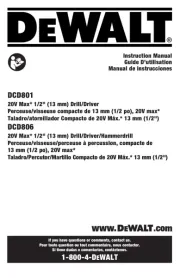
3 Augustus 2025
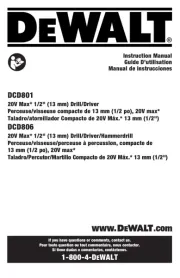
29 Juli 2025

4 Juli 2025
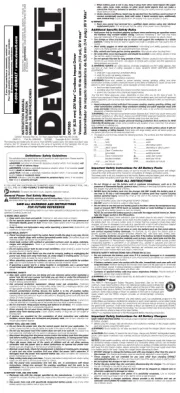
10 Juni 2025

2 Januari 2025

22 November 2024

15 November 2024

2 November 2024

23 September 2024

11 September 2024
Handleiding Boormachine
- Bosch
- Flex
- Go On
- Verto
- NEO Tools
- G-Technology
- Kawasaki
- Proviel
- Gamma
- Tryton
- Dremel
- Toolcraft
- Porter-Cable
- Ecomac
- Powerplus
Nieuwste handleidingen voor Boormachine
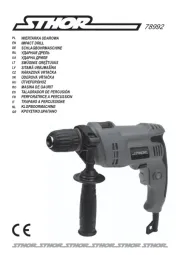
13 September 2025
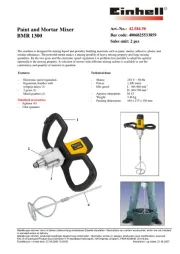
13 September 2025
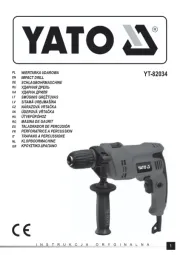
12 September 2025
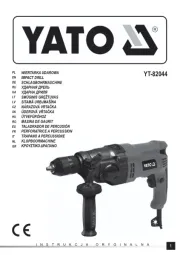
12 September 2025
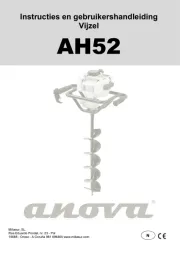
9 September 2025
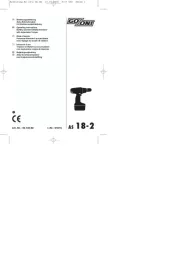
8 September 2025
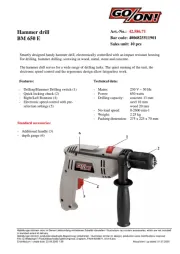
7 September 2025
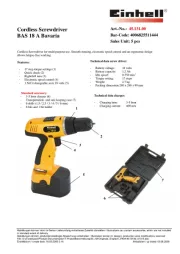
2 September 2025
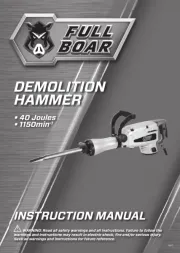
2 September 2025
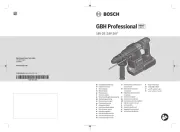
2 September 2025